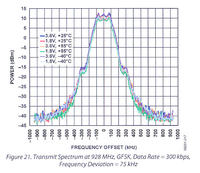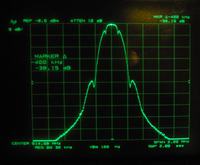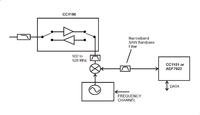biff44
Advanced Member level 6
- Joined
- Dec 24, 2004
- Messages
- 5,046
- Helped
- 1,376
- Reputation
- 2,748
- Reaction score
- 1,056
- Trophy points
- 1,393
- Location
- New England, USA
- Activity points
- 37,902
I am looking for a low cost ISM band (915 Mhz, 2.45 Ghz) transceiver chip with better transmitter spectrum filtering than is commonly available. I have a whole bunch of transmitters running in close proximity, and I want to use the 2nd adjacent channel on a 200 KHz channel plan. For example, while sending data on Channel 50, I want to be able to also use channels 48 and 52 (i.e. 2 x 200 KHz away), even though the "jammer" might be very close in proximity. i.e. I need something that transmitts only in its designated channel, and any extra TX spectrum is tightly filtered out.
I am using a ~ 70 KHz GFSK deviation, and the RF spectrum is bleading thought to +/- 2 channels away so that I am jamming myself. A CC1101 chip, for instance, is only providing 15-20 dB suppression of the "jammer" 2 channels away (250 kbps data rate, using the smallest deviation and narrowest RX filter I can tolerate).
The problem with this whole class of transceiver chips is that, although many have digital filters in the Receiver, they do not have any filtering in the transmit path. That is, they directly connect the transmitter (a modulated VCO) to the antenna. What I was hoping to find was either a:
1) Modulator operating at a lower IF frequency, where I can either digitally filter, or apply an external SAW IF filter to it, and then upconvert with a tunable LO to 915 Mhz band.
or
2) Have a completely digital modulation format, where an DAC generates the signal with some digital band-limiting filter, and the chip then upconverts with a tunable LO.
I can not seem to find such a chip/chipset ANYWHERE. Anyone have a suggestion? I have a very tight materials budget, and can not afford to make up the whole block diagram with discrete elements.
I could do the Transceiver at a lower frequency, like 350 Mhz, and up/downconvert, but still need that low cost 315 MHz chip that has tight TX filtering.
I am using a ~ 70 KHz GFSK deviation, and the RF spectrum is bleading thought to +/- 2 channels away so that I am jamming myself. A CC1101 chip, for instance, is only providing 15-20 dB suppression of the "jammer" 2 channels away (250 kbps data rate, using the smallest deviation and narrowest RX filter I can tolerate).
The problem with this whole class of transceiver chips is that, although many have digital filters in the Receiver, they do not have any filtering in the transmit path. That is, they directly connect the transmitter (a modulated VCO) to the antenna. What I was hoping to find was either a:
1) Modulator operating at a lower IF frequency, where I can either digitally filter, or apply an external SAW IF filter to it, and then upconvert with a tunable LO to 915 Mhz band.
or
2) Have a completely digital modulation format, where an DAC generates the signal with some digital band-limiting filter, and the chip then upconverts with a tunable LO.
I can not seem to find such a chip/chipset ANYWHERE. Anyone have a suggestion? I have a very tight materials budget, and can not afford to make up the whole block diagram with discrete elements.
I could do the Transceiver at a lower frequency, like 350 Mhz, and up/downconvert, but still need that low cost 315 MHz chip that has tight TX filtering.
Last edited:


